Bedroom Window Code
How to Plan Egress Windows
When fire pounces, do you have a way out?
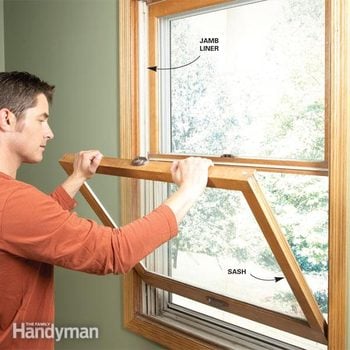 Family Handyman
Family Handyman
Egress windows provide emergency exits in case of fire. We tell you how big they should be and where you need them in your home. If your existing windows aren't big enough, consider remodeling to include them.
You might also like: TBD
- Time
- Complexity
- Cost
- An hour or less
- Beginner
- Free
Egress window logic and the building code
The old saying "Always leave yourself an out" is especially true when it comes to home fires. When the basement stairs are blocked by a flaming television (true story), or fire and thick, black smoke are racing down a hallway toward a dead-end bedroom, windows that are large enough for you to escape—and for firefighters to enter—become essential lifesaving equipment. These all-important escape hatches are called egress windows.
The purpose of this article is threefold:
- To inform you why and where you need egress windows and how big they should be.
- To alert you to the fact that, by today's standards, your bedrooms and basement may very well not have proper-sized egress windows.
- To help you choose the right egress windows and their placement as you build and remodel.
You may have installed smoke detectors, but if you haven't provided a way out once they blare, you've only done half the job. This is especially true for upstairs bedrooms and basements, where the stairway is often the sole escape route. If that stairway is blocked, you can be trapped.
According to the International Building Code, "Basements and sleeping rooms below the fourth story shall have at least one exterior emergency escape and rescue opening. . . . Such opening shall open directly into a public street, alley, yard or court." This "escape and rescue opening" can be a bedroom window, skylight or patio door, but it must meet certain criteria:
- It must have a minimum net clear opening of 5.7 sq. ft. Net clear opening refers to the actual free and clear space that exists when the window is open. It is not the rough opening size or the glass panel size or any other size, but the actual opening a person can crawl through. Code officials want the opening large enough so firefighters can comfortably crawl through the window in full protective gear with an air tank on their back. Ground-floor bedroom windows only need a net clear opening of 5 sq. ft.; they can be smaller because a rescue ladder doesn't take up part of the opening.
- The opening height must be at least 24 in., and the opening width must be at least 20 in.
- The bottom of the clear opening must be within 44 in. of the floor.
- The window or other opening must be operational from the inside without keys or tools. Bars, grilles and grates over windows must be operational without tools or keys and still allow the minimum clear opening.
Note that a window opening that's the bare minimum of 24 in. high and 20 in. wide does not meet egress requirements, since its net clear opening is only 3.33 sq. ft. A window has to be taller and/or wider than these minimums to meet the 5.7-sq.-ft.-opening requirement.
All these numbers may seem daunting, but selecting a new egress window doesn't need to be. Window manufacturers list the net free opening of their windows and skylights in their catalogs, and whether they meet egress requirements.
Figure A: Basic Egress Window Requirements
Few of us think of bedroom windows as lifesaving equipment— but they are! When you need to escape a house fire or other disaster, or when rescue personnel need to enter—the right size egress window can make the difference between life and death. Note: You can download Figure A and enlarge it in the Additional Information section below.
Older homes may not have egress windows
Codes require new homes to have the proper size basement and bedroom egress windows. But if you live in an older, "pre-owned" home, open your bedroom windows fully, pull out a tape measure and see if the opening meets current egress requirements. Multiply the width by the height of the opening to determine whether it's the required 5.7 sq. ft., or 821 sq. in.
Some older homes were built before there were any egress window requirements. Many more homes were built when the egress window net free opening size was a mere 4.3 sq. ft. Yet even newer homes often lack proper egress windows. Attics and basements were often legally remodeled into family rooms or offices (which didn't require egress windows) then later converted into bedrooms (which now do require them). When bedrooms are added to basements without the knowledge of inspectors and without the requisite egress window, they create a dangerous underground fire trap. During remodeling, homeowners often unwittingly replace large egress windows with smaller, non-egress windows. And while most inspectors will demand egress windows be installed when bedrooms are remodeled or added on, they won't necessarily dictate that windows in existing bedrooms be enlarged to egress size; it's simply too difficult to monitor every situation.
Required or not, egress windows are crucial lifesaving equipment. If a room has even the remote possibility of later becoming a bedroom, include an egress size window.
Extra challenges for basements
Basement egress windows present an added challenge. Besides the height, width and overall square-footage requirements that the bedroom window must meet, there are certain requirements for the window well surrounding the window.
Window wells must:
-
- Allow the rescue window opening to be fully opened.
- Provide 9 sq. ft. of "floor area," with a minimum dimension of 36 in. in width and in length.
- Contain a permanently affixed ladder or steps for climbing out if the window well depth exceeds 44 in. The ladder must be at least 12 in. wide and project no less than 3 in. from the window well. It can't be obstructed by the open window or encroach on the required window well dimensions by more than 6 in. If you build the window well from timbers or modular concrete blocks, you can create steps along one side, eliminating the need for a ladder.
We're not done yet. If an egress window is located under a deck or porch, inspectors and firefighters want at least 36 in. between the top of the window well and the bottom of the deck or porch joists; they much prefer 60 in. If the bottom of your egress opening is more than 44 in. from the basement floor, some inspectors will allow you to make up the difference with a permanently attached step.
This sounds like a lot of rigmarole and it is. Installing basement egress windows is challenging. You need to excavate a large hole, cut through and remove concrete, install a large window and window well, keep the basement walls watertight and somehow make the entire thing look good when you're finished. It's a huge project—but ask the family whose flaming television blocked their exit from the basement; they'll tell you how glad they were to have had an egress window.
Figure B: Basement egress Window size Requirements
Basement egress windows and the window well both have to meet rigorous requirements that allow occupants to escape and rescue personnel to enter. Note: You can download Figure B and enlarge it in the Additional Information section below for a full view of standard basement window size.
How to choose an egress window size
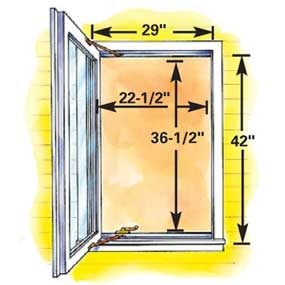
Figure C: Minimum size casement egress window
Casement windows—with hinged sashes that swing free and clear of the opening—can be relatively small and still meet egress requirements. This makes them ideal for basement egress and for other areas where space is limited. The overall size of this "smallest" egress casement window is 8 sq. ft.
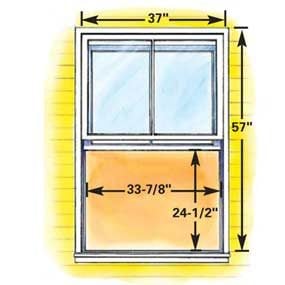
Figure D: Minimum size double-hung egress window
Double-hung windows—with vertically sliding sashes that always fill more than one-half the opening area—have to be pretty big to meet egress requirements. The overall size of this "smallest" double-hung egress window is 14.85 sq. ft., almost twice the area of the egress casement window shown.
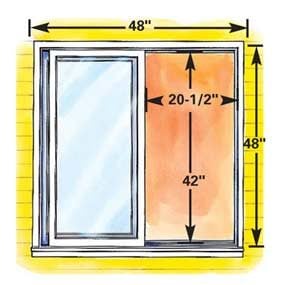
Figure E: Minimum size gliding egress window
Gliding windows— with horizontally sliding sashes that always fill half the possible window opening area— also have to be big to meet egress requirements. The overall size of this "smallest" gliding egress window is 15.5 sq. ft., almost twice the area of the egress casement window shown.
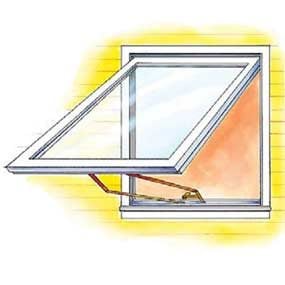
Figure F: Minimum size awning egress window
Awning windows are problematic. Since the opened sash prevents escape from most window wells, they're unsuitable for basement egress. And with most awning windows, the opening hardware and height don't meet egress requirements. Some manufacturers offer models with detachable operators that meet egress requirements.
When it comes to egress, not all bedroom windows are created equal. Figures C – F show how any style window can meet egress requirements—some just do it more space efficiently than others. As you remodel, you'll want new egress windows that match the style of the existing windows and meet egress requirements. This can be a challenge. Bear in mind these pros and cons.
Casement windows: These side-hinged windows fulfill egress requirements while taking up the smallest amount of wall space. This makes them ideal for egress windows in basements or other areas where space is limited. Some manufacturers can install a special operator arm that allows the window to open wider than the standard bedroom window size operating arm to meet egress requirements. Others have an operator arm that can be pushed to open the window wider in an emergency. These meet egress requirements as long as you leave the "PUSH HERE" label in place.
Double-hung windows: Even when it's fully open, more than half of a double-hung window's overall area is blocked by glass. This means that to meet egress window height requirements, a bedroom window must be nearly 4 ft. 9 in. in overall height. This height requirement takes it out of the running for most basement egress situations.
Gliding windows: To meet egress requirements, these horizontally sliding windows must be at least 4 ft. wide and 4 ft. high. This extra glass area and the light it lets in are pretty darn nice in a basement area, if you have the space.
Awning windows: These top-hinged windows make lousy egress windows. They don't meet egress requirements in basements because the opened sash impedes entrance and exit. And those with center opening mechanisms don't meet code because the hardware gets in the way. Only those with special hardware will meet egress requirements—and there aren't many available.
Certain skylights meet egress requirements as long as they're installed within 44 in. of the floor.
If you're replacing a smaller window with a larger one that meets egress requirements, bear in mind that enlarging the height of the opening takes less structural work than enlarging the width. Increasing width means installing a larger, beefier horizontal structural header over the window opening—a major project. Increasing height is often only a matter of lowering the height of the sill below the window.
Additional Information
- Figure A: Basic egress window requirements
- Figure B: Basement egress window requirements
Similar Projects
Source: https://www.familyhandyman.com/project/how-to-plan-egress-windows/

Posting Komentar